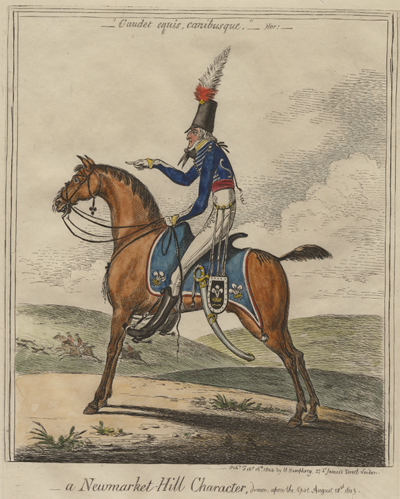A Newmarket Hill Character
At its most basic, caricature tends towards simplification, especially simplification of form. In A Sphere Projecting against a Plane (1792), Gillray had explicitly called attention to that tendency by showing us two of his favorite subjects, Mrs. Albinia Hobart and William Pitt reduced to their logical geometric forms.
Here, in A Newmarket Character, he does something very similar—presenting Lieutenant-Colonel George Leigh on horseback as a series of arcs: the arc of his back, the arc of his boots, the arc of his sword, the arc of his horse's neck, rump and tail. Even the normally blank background of most portrait caricatures is here a series of arcs representing the Sussex downs.

© Prints, Drawings and Watercolors from the Anne S.K. Brown Military Collection.
Brown Digital Repository. Brown
University Library.
George Leigh (1771–1850) was the son of General Charles Leigh. At the age of 19, he was commisioned as a cornet in the Prince of Wales own 10th Light Dragoons (1790), and over the next nine years advanced to 2nd lieutenant-colonel (1799). Because of their association with the future King, the 10th light dragoons were distinguished by their "elaborate and expensive uniforms and the high personal income required to be an officer." In Gillray's print, the insignia of the Prince of Wales (crown and plumes) can be seen on the sabretache (the leather pouch suspended from his belt) and the beautiful blue saddle cloth. In around 1801, Leigh was caricatured by Robert Dighton in a drawing that is part of the Royal Collection Trust, so we can get another roughly contemporaneous view of his thoroughly unprepossessing profile.

George Leigh
[~1801]
© Royal Collection Trust
The caption for Gillray's print says it was "drawn upon the spot August 13, 1803." And in fact, there is compelling evidence that Leigh himself WAS on the spot on Newmarket Hill on August 13, 1803. The day before had been the Prince of Wales's birth day, so naturally there were celebrations and events throughout the country. The August 15 edition of the London Morning Post included this report from Brighton.
The town on the Birth Day was never known to be in such a bustle before, in consequence of the Ball at night and the Review on the following morning. About two o'clock the drums beat to arms and a general muster took place about three o'clock, on the parade at the lower end of the Steyne. Four o'clock was the hour appointed by His Royal Highness, the Field Marshal, for the troops to be under arms on the Newmarket hill, about four miles from Brighton on the Lewes road. The Prince's regiment, the 10th Light Dragoons, was among the first on the ground. The other troops from Brighton and its immediate vicinity were, the South Gloucester, Sussex, and South Hants regiments of militia, and the artillery and the rifle corps. From Lewes came the Dorset and the North Hants, and the yeoman calvalry, mustering altogether about four thousand men.
With 4000 men on the Newmarket Hill as part of the review, it is unlikely that Leigh could have participated in a hunt in the same area on the 13th. But according to A History of Newmarket Farm, the
Brookside Harriers, met every week on Newmarket Hill. They hunted hares on horseback using a breed of beagle specially used to hunt them by smell, unlike greyhounds that hunt by sight. The relatively slow beagles meant that even poor riders were able to keep up, and the hare could be followed a good long distance, and had a sporting chance of getting away.
So it's possible that the print was sketched "on the spot" but on another day while Leigh's regiment was in Brighton for the Prince's birthday. Some sort of mistake as this is even more likely because the print was not etched (or at least not published) until February 1804.
At the top of the print, there is a Latin quotation from Horace's The Art of Poetry—"Gaudet equis, canibusque."* Appropriately for a print showing Leigh as part of a Newmarket hunt, it means "he finds joy in horses and dogs." But the quotation comes from a passage in which Horace is advising the would-be poet to adapt his style to "the manners of each age, and give a befitting tone to the shifting natures and their years."
The beardless youth, freed at last from his tutor, finds joy in horses and hounds and the grass of the sunny Campus, soft as wax for moulding to evil, peevish with his counsellors, slow to make needful provision, lavish of money, spirited, of strong desires, but swift to change his fancies.
How much of this context we are to read into Gillray's portrait of Leigh is of course debatable. But the few accounts of his character that I've been able to find are consistent with Horace's description. On the occasion of Leigh's marriage with his cousin, Augusta Byron, Earl Temple wrote in his diary "Poor Augusta Leigh marries today! Poor thing! I pity her connecting herself with such a Family and such a fool!" And in later life he is supposed to have "brought shame on their family when, as equerry to the Prince of Wales, he cheated him over the sale of a horse, fiddled his own regimental expenses to fund his gambling, and was dismissed."
* All citations from Horace are from the Loeb Classical Library edition.
Sources and Reading
- Commentary from the British Museum on A Newmarket Hill Character.
- "Hunting and Mock Battles," A History of Newmarket Farm
- "Newmarket Hill, Sussex," Wikipedia
- "10th Royal Hussars," Wikipedia
- "Augusta Leigh," Wikipedia
- "Byron treasure found in gift to used bookshop," Independent
Comments & Corrections
NOTE: Comments and/or corrections are always appreciated. To make that easier, I have included a form below that you can use. I promise never to share any of the info provided without your express permission.